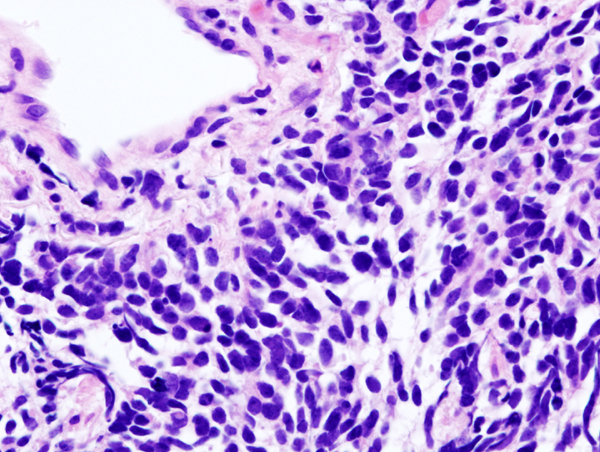Lung cancer classification
|
Lung cancer Microchapters |
|
Diagnosis |
|---|
|
Treatment |
|
Case Studies |
|
Lung cancer classification On the Web |
|
American Roentgen Ray Society Images of Lung cancer classification |
|
Risk calculators and risk factors for Lung cancer classification |
Editor-In-Chief: C. Michael Gibson, M.S., M.D. [1]; Associate Editor(s)-In-Chief: Kim-Son H. Nguyen, M.D., M.P.A., Beth Israel Deaconess Medical Center, Harvard Medical School, Boston MA, Cafer Zorkun, M.D., Ph.D. [2]
Overview
| Frequency of histological types of lung cancer[1] | ||||||||||||
| Histological type | Frequency (%) | |||||||||||
|---|---|---|---|---|---|---|---|---|---|---|---|---|
| Non-small cell lung carcinoma | 80.4 | |||||||||||
| Small cell lung carcinoma | 16.8 | |||||||||||
| Carcinoid[2] | 0.8 | |||||||||||
| Sarcoma[3] | 0.1 | |||||||||||
| Unspecified lung cancer | 1.9 | |||||||||||
The vast majority of lung cancers are carcinomas—malignancies that arise from epithelial cells. There are two main types of lung carcinoma, categorized by the size and appearance of the malignant cells seen by a histopathologist under a microscope: non-small cell (80.4%) and small-cell (16.8%) lung carcinoma.[1] This classification, based on simple histological criteria, has important implications for clinical management and prognosis of the disease.
Non-small cell lung carcinoma (NSCLC)
The non-small cell lung carcinomas are grouped together because their prognosis and management are similar. There are three main sub-types: squamous cell lung carcinoma, adenocarcinoma and large cell lung carcinoma.
| Sub-types of non-small cell lung cancer[1] | ||||||||||||
| Histological sub-type | Frequency of all lung cancers (%) | |||||||||||
|---|---|---|---|---|---|---|---|---|---|---|---|---|
| Squamous cell lung carcinoma | 31.1 | |||||||||||
| Adenocarcinoma | Adenocarcinoma (not otherwise specified) | 23.2 | ||||||||||
| Bronchioloalveolar carcinoma | 3.0 | |||||||||||
| Adenosquamous carcinoma | 1.2 | |||||||||||
| Papillary adenocarcinoma | 0.7 | |||||||||||
| Mucoepidermoid carcinoma[4] | 0.1 | |||||||||||
| Adenoid cystic carcinoma[5] | 0.04 | |||||||||||
| Other specified adenocarcinoma | 1.1 | |||||||||||
| Large cell carcinoma | 10.7 | |||||||||||
| Giant cell and spindle cell carcinoma | 0.4 | |||||||||||
| Other/unspecified non-small cell lung carcinoma | 8.9 | |||||||||||
Accounting for 31.1% of lung cancers,[1] squamous cell lung carcinoma usually starts near a central bronchus. Cavitation and necrosis within the center of the cancer is a common finding. Well-differentiated squamous cell lung cancers often grow more slowly than other cancer types.[6]
Adenocarcinoma accounts for 29.4% of lung cancers.[1] It usually originates in peripheral lung tissue. Most cases of adenocarcinoma are associated with smoking. However, among people who have never smoked ("never-smokers"), adenocarcinoma is the most common form of lung cancer.[7] A subtype of adenocarcinoma, the bronchioloalveolar carcinoma, is more common in female never-smokers, and may have different responses to treatment.[8]
Accounting for 10.7% of lung cancers,[1] large cell lung carcinoma is a fast-growing form that develops near the surface of the lung.[9] It is often poorly differentiated and tends to metastasize early.[6]
Small cell lung carcinoma (SCLC)

Small cell lung carcinoma (SCLC, also called "oat cell carcinoma") is less common. It tends to arise in the larger breathing tubes and grows rapidly, becoming quite large.
The "oat" cell contains dense neurosecretory granules (vesicles containing neuroendocrine hormones) which give this an endocrine/paraneoplastic syndrome association.[10]
While initially more sensitive to chemotherapy, it ultimately carries a worse prognosis and is often metastatic at presentation. This type of lung cancer is strongly associated with smoking.[11]
Metastatic cancers
The lung is a common place for metastasis from tumors in other parts of the body. These cancers are identified by the site of origin, thus a breast cancer metastasis to the lung is still known as breast cancer. They often have a characteristic round appearance on chest x-ray.[12]
Primary lung cancers themselves most commonly metastasize to the adrenal glands, liver, brain, and bone.[6]
References
- ↑ 1.0 1.1 1.2 1.3 1.4 1.5 Travis, WD (Jan 1995). "Lung cancer". Cancer. 75 (Suppl. 1): 191–202. PMID 8000996. Unknown parameter
|coauthors=ignored (help) - ↑ Morandi, U (2006). "Bronchial typical carcinoid tumors". Seminars in Thoracic and Cardiovascular Surgery. 18 (3): 191–198. PMID 17185178. Unknown parameter
|coauthors=ignored (help) - ↑ Etienne-Mastroianni, B (Dec 2002). "Primary sarcomas of the lung: a clinicopathologic study of 12 cases". Lung Cancer. 38 (3): 283–289. PMID 12445750. Unknown parameter
|coauthors=ignored (help) - ↑ Sánchez-Mora, N (Jan 2007). "Mucoepidermoid tumors of the bronchus. Ultrastructural and immunohistochemical study". Histology and Histopathology. 22 (1): 9–13. PMID 17128406. Unknown parameter
|coauthors=ignored (help) - ↑ Moran, CA (Mar 1994). "Primary adenoid cystic carcinoma of the lung. A clinicopathologic and immunohistochemical study of 16 cases". Cancer. 73 (5): 1390–1397. PMID 7509254. Unknown parameter
|coauthors=ignored (help) - ↑ 6.0 6.1 6.2 Vaporciyan, AA (2000). Cancer Medicine. B C Decker Inc. pp. 1227–1292. ISBN 1-55009-113-1. Unknown parameter
|coauthors=ignored (help) - ↑ Subramanian, J (February 2007). "Lung cancer in never smokers: a review". Journal of Clinical Oncology. American Society of Clinical Oncology. 25 (5): 561–570. PMID 17290066. Unknown parameter
|coauthors=ignored (help) - ↑ Raz, DJ (Mar 2006). "Bronchioloalveolar carcinoma: a review". Clinical Lung Cancer. Cancer Information Group. 7 (5): 313–322. PMID 16640802. Unknown parameter
|coauthors=ignored (help) - ↑ Veronesi G (Jul 2006). "Large cell neuroendocrine carcinoma of the lung: a retrospective analysis of 144 surgical cases". Lung Cancer. 53 (1): 111–115. doi:10.1016/j.lungcan.2006.03.007. PMID 16697073. Unknown parameter
|coauthors=ignored (help) - ↑ Rosti, G (Mar 2006). "Small cell lung cancer". Annals of Oncology. 17 (Suppl. 2): 5–10. doi:10.1093/annonc/mdj910. PMID 16608983. Retrieved 2007-09-06. Unknown parameter
|coauthors=ignored (help) - ↑ Barbone, F (Dec 1997). "Cigarette smoking and histologic type of lung cancer in men" (PDF). Chest. American College of Chest Physicians. 112 (6): 1474–1479. PMID 9404741. Retrieved 2007-09-07. Unknown parameter
|coauthors=ignored (help) - ↑ Seo, JB (2001). "Atypical pulmonary metastases: spectrum of radiologic findings". Radiographics. 21 (2): 403–417. PMID 11259704. Retrieved 2007-09-10. Unknown parameter
|coauthors=ignored (help)